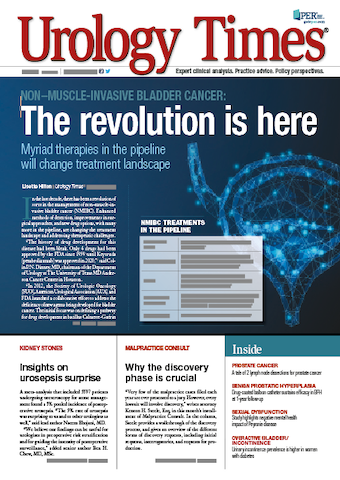New partnership launches novel test for hereditary prostate cancer risk
NorthShore University HealthSystem (NorthShore) and GoPath Laboratories have partnered to launch the ProstateNow genetic test for determining an individual’s inherited risk of developing prostate cancer.1
Using a blood or saliva sample, ProstateNow employs a 3-pronged approach for assessing risk: family history (FH), rare pathogenic mutations (RPMs), and a genetic risk score (GRS) that was developed by Northshore. Results of the test, which are available within 10 to 14 days, can be used by urologists to make recommendations on both screening and treatment.
ProstateNow includes a 14-gene panel to detect mutations linked to hereditary prostate cancer. These mutations are ATM, BRCA1, BRCA2, CHEK2, EPCAM, HOXB13, MLH1, MSH2, MSH6, NBN, PMS2, PALB2, RAD51D, and TP53. The novel tool also examines over 100 single nucleotide polymorphisms associated with prostate cancer risk.
“Family history, rare pathogenic mutations and genetic risk score each measure risk independently,” Brian Helfand, MD, Division Chief of Urology and Director of the John and Carol Walter Center for Urological Health at NorthShore, stated in a press release. “Combining all three tools provides the most comprehensive inherited risk assessment for patients and their families.”
“Importantly, African Americans have a higher incidence of prostate cancer than the general population, but comprehensive genetic tests have been less available to people who are not Caucasian,” added Helfand. "We're thrilled to offer this innovation to all our patients—including Black members of our community—who can benefit from more informed treatment plans and the potential for more targeted prostate cancer therapies.”
A paper recently published in European Urology supports the 3-pronged ProstateNow approach for predicting prostate cancer incidence and mortality.2 The study consisted of a large prospective cohort of 208,685 patients from the UK Biobank database who had not been diagnosed with prostate cancer at the time of recruitment. The investigators compared GRS with FH and RPMs as predictors of prostate cancer incidence and mortality.
Across the study population, there were 6890 cases of prostate cancer identified and 419 prostate cancer–related deaths at a median follow-up of 9.67 years. Univariate analyses showed that all 3 measures were significantly associated with the incidence of prostate cancer. The rate ratios were 1.88, 2.89 and 1.97 for FH, RPMs, and GRS, respectively (P <.001 for all). Multivariable analyses showed that the associations were independent. The measures of FH and RPMs determined that 11% of men had higher prostate cancer risk, and the addition of GRS identified another 22% of men with higher prostate cancer risk.
The investigators also used C-statistic as a marker of comparison. For predictive models, the C-statistic ranges from 0.50 to 1.00 and higher values are indicative of better models. The researchers showed that adding GRS to FH and RPM increased the C-statistic from 0.58 to 0.67 (P <.001) and from 0.65 to 0.71 (P = .002) for differentiating incidence and differentiating mortality, respectively.
“This population-based prospective study suggests that GRS complements two guideline-recommended inherited risk measures (FH and RPMs) for stratifying the risk of prostate cancer incidence and mortality,” the investigators wrote. “These results provide critical data for including GRS in prostate cancer risk assessment.”
ProstateNow can be accessed online on GoPath’s website. Medicare covers the test for qualifying patients, but they must first receive a referral from a urologist or other physician.
References
1. NorthShore University HealthSystem and GoPath Laboratories Partner to Offer the Most Comprehensive Inherited Risk Assessment for Prostate Cancer with PROSTATENOW™. Published online April 6, 2021. Accessed April 6, 2021.https://prn.to/3rQiR1z.
2. Shi Z, Platz EA, Wei J, et al. Performance of three inherited risk measures for predicting prostate cancer incidence and mortality: a population-based prospective analysis. Eur Urol. 2021;79(3):419-426. doi: 10.1016/j.eururo.2020.11.014

Study finds disparities in management of mCSPC
April 17th 2024“These findings suggest that guideline recommended treatment intensification remains low for patients with mCSPC in both Medicare and the Veterans Health Administration, but especially for Black patients,” says Daniel J. George, MD.
